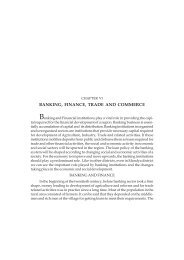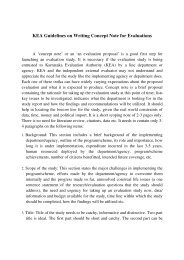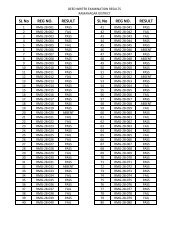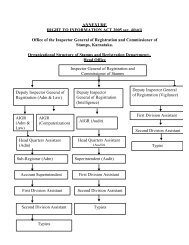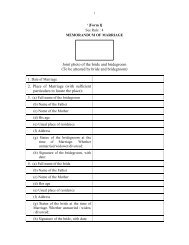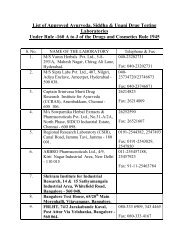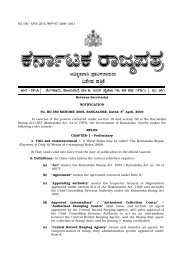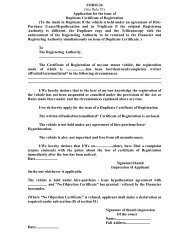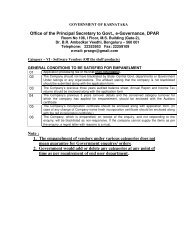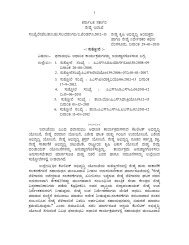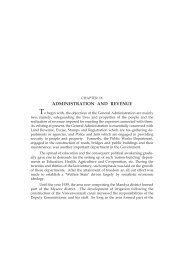NEEM
NEEM
NEEM
Create successful ePaper yourself
Turn your PDF publications into a flip-book with our unique Google optimized e-Paper software.
Azadirachta indica A. JUSS.<br />
Family: MELIACEAE<br />
<strong>NEEM</strong><br />
Neem is a tall evergreen tree having small bright<br />
green leaves. It is up to 100 feet tall. The stem of a neem<br />
tree can grow up to a diameter of 2.5-3 m. The bark is<br />
rough and can be pale or greyish-black in color. Neem tree<br />
bears small white colored flowers and star shaped, with a<br />
pleasant smell. The tree generally bears fruits between the<br />
age of 3 and 5, and the fruits are edible.<br />
Common Names<br />
Sanskrit: Nimba, Arishta, Ravipriya<br />
Kannada: Bevina-mara, Bevu, Kahibevu, Nimba, Ollebevu<br />
English: Neem, Margosa margosa,<br />
Telugu: Vepa<br />
Tamil: Vembu<br />
Malyalam: Veppu<br />
Distribution:<br />
This species is probably native to India globally distributed in the Indian subcontinent.<br />
Within India, it is commonly found throughout the greater part, and is often cultivated. In<br />
Karnataka, in large quantity found in Agumbe, Sandur, Devarayandurga Karpakkapalli<br />
Agroclimatic Requirements:<br />
It grows on a variety of soils, from sandy to clayey including black cotton soils. Neem<br />
grows well on flat ground with high sub-soil water level and good drainage. It tolerates<br />
temperature ranging from 0°C to over 40°C, altitude variation from sea level to 1500 m and an<br />
extremely low annual rainfall down to 130 mm. It also possesses certain amount of drought<br />
hardiness. Neem grows well on moist, dry, stony, clayey or shallow soil. It can tolerate a soil pH<br />
of 5-10.
Varieties: There is no named variety in this crop<br />
Cultivation: It can be propagated using seeds.<br />
Seed Propagation:<br />
Seeds have a short viability of about two weeks. For obtaining higher germination, seeds<br />
are soaked for 24 hours in cold water and the endocarp is removed or the seed coat at the round<br />
end is cut off with a sharp knife. De-pulped seeds should be sown in nursery beds made of fine<br />
river sand preferably, in lines 15 to 20 cm apart and seeds 2.5 to 5 cm apart, at a depth of 1 to 2<br />
cm and is lightly covered by the soil, the beds are sparingly watered to prevent caking.<br />
Germination takes about one to two weeks and 70 to 90 percent seeds germinate.<br />
Transplanting and aftercare<br />
Seedlings about 7 to 10 cm tall with tap root of about 15 cm long are transplanted into<br />
polybags. Field planting is done after 1 to 2 years at a spacing of 4.5 to 5.5 m. They are usually<br />
watered once in a while during summer months for the first 5 to 6 years.<br />
Irrigation and Interculture:<br />
Neem requires hardly any irrigation during monsoon. However, light irrigation during the<br />
summer season supports good growth of the seedlings. Matured trees do not require any<br />
irrigation.<br />
Periodically pruning of the tree once in a year during November – December provides a<br />
good frame work and faster growth of the tree.<br />
Inputs:<br />
Sl No Materials Per acre Per hectare<br />
Plant Protection:<br />
1 Number of seedlings (g) 112 280<br />
2 Farmyard Manure (t) 10 25<br />
3 Fertilizers (kg) -<br />
Major Insect: Thrips, defoliator, Shoot borer and termites<br />
Major Diseases: the plant is not attack by any disease of serious nature
Schedule:<br />
• To control thrips spray dimethoate @ 0.1- 0.2 ml per liter of water<br />
• The larvae of shoot borer can be controlled by spraying 0.02% of monocrotophos<br />
• Spray of 0.1-0.2% folithion checks the defoliator<br />
• To control termites’ heptachlor or chlordane, 50EC should be drenched before<br />
Harvest and Yield:<br />
planting the seedlings and also after planting if the pest is noticed on the stem.<br />
Scented white flowers appear in abundance on axillary spikes during March-April. Fruits<br />
ripen from June to August. Fruits are harvested when the color of the fruit turns from green to<br />
bright yellow. Vigorous shaking of the branches is required to collect the ripe fruits<br />
About 8000- 10000 kgs of fresh berries can be harvested from 1ha/ yr. Fresh fruits give about<br />
60% dry fruits, which yield 10% kernel and contain on an average 45% fixed oil.<br />
Cost of Cultivation: Approximate cost of cultivation comes around Rs.37, 500/- per hectare.<br />
Parts used: All parts<br />
Medicinal uses:<br />
The all parts of Neem are used in the form of juice and decoction to treat fever, intrinsic<br />
haemorrhage, bleeding piles, wound, oedema, arthritis, skin diseases, diabetes, eye diseases,<br />
leucorrhoea, as, poisons, jaundice, for fumigation, diseases of teeth, heart diseases, as specific<br />
digestive and diseases of vagina.<br />
Intake of haritaki (Terminalia chebula) and nimba or nimba and amalaka (Phyllanthus emblica)<br />
(40-60 ml) decoction for a month helps to overcome all types of skin diseases.<br />
Decoction of bark, leaves, root, fruit and flowers of neem, aragvadha (Cassia fistula), saptaparna<br />
(Alstonia scholaris), murva (Maerua arenaria), kutaja (Holarrhena antidysenterica), katphala<br />
(Gmelina arborea) and palasa (Butea monosperma) (40-60 ml) destroys all types of diabetes.<br />
Decoction of neem leaves used to clean the wound. Neem leaf mixed with honey acts as wound<br />
cleansing agent. Both of them (10-15 gm) added with ghee promote wound healing. Paste of<br />
neem leaves and sesamum mixed with honey cleanses wound, while mixed with ghee it acts as<br />
healing agent. The paste of neem leaves (10-15 gm) when given internally decrease pitta and<br />
kapha and useful in worm infestation.



